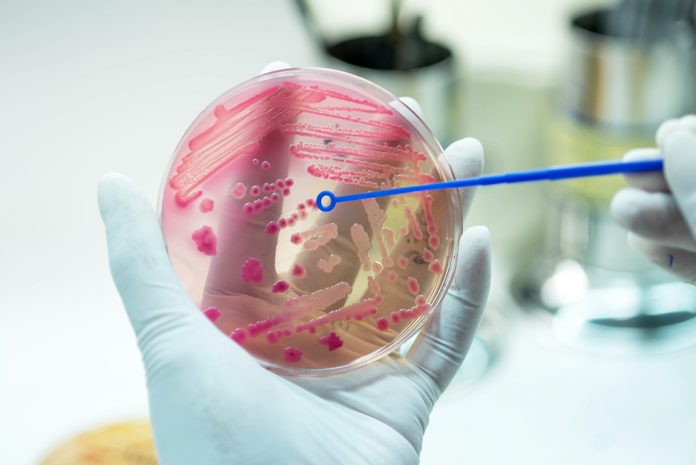SACIDS Africa Centre of Excellence for Infectious Diseases trains young African scientists in research on global health issues: An example of a PhD Student Research on antimicrobial resistance (AMR)
What is the study about?
Antimicrobial resistance (AMR) is currently a global health concern but disproportionately affects developing countries. In these countries, including Tanzania, farming of domestic pigs and poultry involves intense and uncontrolled use of both human and veterinary drugs, which poses a significant threat to the emergence and spread of pathogens that are resistant to the commonly available antimicrobial agents. Such microorganisms are a common cause of both hospital and community infections, which are difficult to treat. The study aims to determine the genomic epidemiology of Multidrug-Resistant (MDR) Escherichia coli in domestic pigs, poultry, fish and the environment and the drivers for antimicrobial use and resistant through (i) collection of surveillance information on the drivers for antimicrobial use and resistance in animal and environment; and (ii) bacterial isolation, antimicrobial susceptibility tests and tests for genetic diversity of MDR E.coli through molecular characterization. The genomic component of the study aims to track the spread of the resistomes.
What is the problem that triggers the conduct of this study?
The demand for food of animal origins in Tanzania has been associated with the intensive farming of domestic pigs and poultry, especially in urban and peri-urban areas. The national projection data shows that annual chicken meat and domestic pig production was to increase from 130,000 tonnes in 2017 to 465 tonnes in 2020 and from 22,000 in 2017 to 37,200 tonnes in 2022, respectively. This increase is linked to the increase in urbanization rate and trading of live animals and animal products.
Often, animals are kept in overcrowded and unhygienic conditions that led to frequent infections. As a result, farmers use antimicrobials for treatment and/or prevention to control diseases and as growth promoters to reduce management costs. The most common antimicrobial classes used included tetracycline, quinolones, sulphonamides, anthelminthic, penicillin and aminoglycosides. The extended use and misuse of antimicrobials in animal farming has been implicated in the occurrence and spread of AMR bacteria in food animals and the environment, with subsequent involvement of humans. There is scarce information on the surveillance and status of antimicrobial usage and resistance in animal production and genetic relatedness of MDR E.coli across domestic pigs, poultry, and the environment in the country.
What is the importance of this research?
Previous studies have revealed that antimicrobial-resistant genes can be transmitted across humans and animals through the environment, which act as a reservoir of resistant genes. Human activities and behaviours that promote transmission of AMR organisms are very high in Tanzania as is the case in many developing countries. Antimicrobial agents, especially in animal farming, are used without any regulation, and often veterinary drugs can be obtained over the counter without advice from veterinary officers. Often, there is misdiagnosis of diseases, improper dosage and lack of implementing the withdrawal period. Unfortunately, the existing veterinary acts and policies are hardly implemented and the protection of environmental contamination is hardly enforced. This scenario provides an avenue for animal farming to be a significant driver of AMR pathogens that can spread through the environment to reach humans.
Why is it important to conduct this study along the Msimbazi river basin?
The Msimbazi River basin, which covers an area of 271 km², harbours approximately four million people, making it the most densely populated area in Tanzania. Multiple activities are undertaken in this basin, including intensive crop and livestock farming, industrial companies, fishing and sand mining. The basin, which is located in Dar es Salaam, the commercial city of Tanzania, is highly polluted by effluents originating from the leakage of effluents from waste dumps, abattoirs, and domestic wastewater from septic tanks and pit latrines. The area is very ideal for the study for the following three reasons: 1) a high interaction of people undertaking a variety of activities; 2) environmental contamination by effluents and other types of wastes from different sources and; 3) apart from the high level of contamination reported in different studies, no study has been conducted on antimicrobial resistant.
What are the main findings to-date?
At the beginning of this project, a review was conducted to determine the status antimicrobial use and resistance in animal farming and environment across the African region. Information was searched through PubMed, Google Scholar, Web of Science, and African Journal Online databases. Full-length original research and review articles on antimicrobial use, the prevalence of AMR from Africa covering a period from 2005 to 2018 were examined. The articles were scrutinised to extract information on the antimicrobial use, resistance and surveillance systems. A total of 200 articles were recovered. Of these, 176 studies were included in the review while 24 articles were excluded because they were not relevant to antimicrobial use and/or resistance in food animals and the environment. The percentage of farms using antimicrobials in animal production ranged from 77.6% in Nigeria to 100% in Tanzania, Cameroon, Zambia, Ghana and Egypt. The most antibiotics used were tetracycline, aminoglycoside and penicillin groups. The percentage of multidrug-resistant isolates ranged from 20% in Nigeria to 100% in South Africa, Zimbabwe and Tunisia. In the environment, the percentage of multidrug-resistant isolates ranged from 33.3% in South Africa to 100% in Algeria. None of the countries documented national antimicrobial use and a resistance surveillance system in animals. This work has been published in the journal of antimicrobial resistance and infection control and can be accessed at https://doi.org/10.1186/s13756-020-0697-x.
Subsequently, assessment of drivers concerning antimicrobial use and resistance in poultry and domestic pig farming was conducted in the Msimbazi River Basin, Tanzania. Data collected through questionnaires, focus group discussions and in-depth interview revealed that 87.6% of the antimicrobials are used for disease prevention compared with 80.5% for disease treatment. AMU was associated with low cost and easy access to antimicrobial agents. About 89.4% of the antimicrobials used were obtained over the counter and stocking of veterinary items and drugs at home was practised by 62.8% of the respondents interviewed. Most farmers (95.6%) lacked access to veterinary and extension services and resorted to fellow farmers for advice or used their own experience in making treatment decisions. We found about (78.8%) of uncontrolled disposal of wastes from households, 85% of improper disposal of human and veterinary drugs and 92.9% of agricultural activities that involves the use of animal manure are major contributors of environmental contamination.
Faecal materials collected from poultry and domestic pigs along the study areas revealed high isolation frequency of E.coli (75.8%) compared with Klebsiella species (5.5%). The higher percentage of resistance both in poultry and domestic pigs was for tetracycline (65.6%), followed by nalidixic acid (58.7%), doxycycline (58.4%), sulfamethoxazole-trimethoprim (57.9%) and ampicillin (53.7%). Poultry harboured isolates that were more resistant to the tested antibiotics. The identified isolates exhibited MDR property against the eight antimicrobial class tested that is quinolone, phenicol, aminoglycosides, penicillin, tetracycline, sulphonamides, cephalosporin and carbapenems. About 82.4% of the E.coli isolates were extended-spectrum beta-lactamase (ESBL) producers, capable of hydrolysing penicillins, broad-spectrum cephalosporins and monobactams and 44% were resistant to quinolones, which renders ciprofloxacins and nalidix acid ineffective.
What is the relevance of the findings?
These findings highlight the high usage of veterinary antimicrobials which are accompanied by a lack of surveillance systems, inadequate veterinary services, weak implementation of the legal framework and poor animal management practices. The high level of antimicrobial use has led to a high level of AMR and MDR organisms in poultry and pig in the Msimbazi area. The high percentage of ESBL producers and quinolone-resistant bacteria renders most of the currently used antibiotics such as ampicillin, penicillins, and ciprofloxacin ineffective, and their use is likely to exacerbate the burden of AMR.
What are the next steps?
The resistant E.coli from poultry, domestic pigs and environmental samples will be subjected to molecular characterization by polymerase chain reaction (PCR) and whole genome sequencing (WGS) to examine genetic relatedness and diversity in order to determine the flow of resistomes across the animal and environmental compartments. Environmental samples, which are currently being collected include household slurry, river water, sediments, soils, fish and from markets, abattoirs, hospital surroundings.
Conclusion
The high level of AMU, AMR and MDR from the poultry and domestic pigs is an indication that the general community is exposed to the burden of antimicrobial resistance. The lack of surveillance systems, inadequate veterinary services, agricultural activities that involve the use of manure from the farmed animals and weak implementation of regulatory framework both in animals and the environment is likely to escalate the problem of antimicrobial resistance and multidrug resistance. As such, multisectoral One Health (OH) interventions are urgently needed, as well as a thorough review of government policy and regulations to ensure judicious use of antimicrobials in animal farming to protect the environment from contamination with antimicrobial agents to achieve a better and brighter future for all and to attain sustainable development goals (SDGs).
Zuhura Kimera, BSc, MSc, PhD Student
SACIDS Foundation for One Health & Muhimbili University of Health and Allied Sciences Department of Microbiology and Immunology, School of Medicine
PhD Research Title: Genomic epidemiology of multidrug resistant (MDR) Escherichia coli in poultry, pigs, fish and environment and the drivers for antimicrobial use and resistance in Dar es Salaam and Pwani Regions in Tanzania.
Please note: This is a commercial profile











